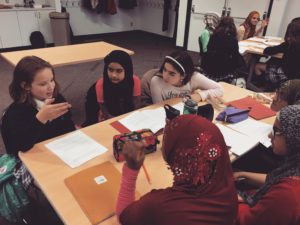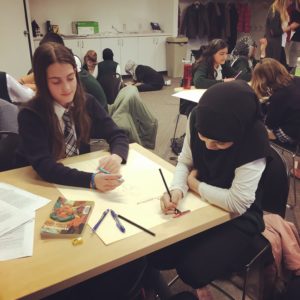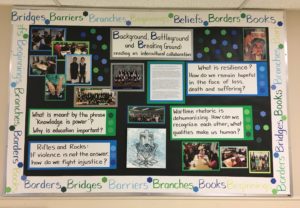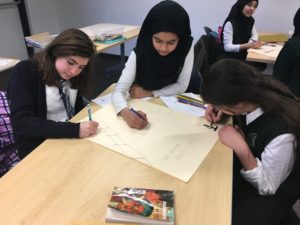Though many public schools in Calgary are comprised of students from diverse backgrounds, the city’s mosaic also includes pockets of private educational institutions, designed to serve specific populations. Students from different religious, linguistic, and cultural contexts have the option to attend schools that are expressly French, Chinese, Christian, Muslim, or Jewish, to name a few. Public places of intersection, and more culturally homogenous institutions, are equally important to the fabric of our city. Both private and public schools function to celebrate our unique and communal identities as Calgarians. That said, each institution presents with its own set of challenges and opportunities related to cultural identity, and multicultural awareness.
As a teacher, traveler, global citizen and local Calgarian, facilitating cross-cultural conversation is an ongoing passion project of mine. I am ever searching for ways to celebrate—and transcend—our differences. As an educator, cultivating more nuanced discussions means inviting increasingly diverse perspectives to the infamous Table. At the core of my work is simply the belief that the true-est truths lay in the intersections of our shared humanity; that we are better together.
 This year I brought my students from the Calgary Jewish Academy to meet with those from Almadina Charter School (an ESL school that is primarily Muslim) for the purposes of an intercultural novel study. We read Deborah Ellis’ book, The Breadwinner (Groundwood Books, Toronto; 2000). The novel features a young Afghani protagonist named Parvana, denied the right to attend school and forced to disguise herself in an effort to provide for her family under the rule of the Taliban.
This year I brought my students from the Calgary Jewish Academy to meet with those from Almadina Charter School (an ESL school that is primarily Muslim) for the purposes of an intercultural novel study. We read Deborah Ellis’ book, The Breadwinner (Groundwood Books, Toronto; 2000). The novel features a young Afghani protagonist named Parvana, denied the right to attend school and forced to disguise herself in an effort to provide for her family under the rule of the Taliban.
Why this particular book, at this particular time? As many of us are well aware, Jewish-Islamic relations on the global stage are anything but peaceful. Crises in the Middle East highlight the constant battle between Israel as a Jewish country, and nations with a predominantly Muslim population like Afghanistan, Pakistan, Iraq and others. The Jewish continued desire for self-determination in their ancestral homeland, is at odds with the desire for national unity held by Arab populations in the region. This territorial conflict is also religious and cultural in nature.
The purpose of the intercultural book club was to elucidate a false dichotomy at the centre of the feud. On both sides of the ‘Us vs. Them’ divide, exist Jewish and Muslim people who see otherness as a threat, and those who seek cooperation and peace. The true conflict lives in a much more nuanced place: in the hearts of those oriented towards fear, and those aligned with love.
Students from two independent schools represented the brave and insightful voices on either side of the ideological fence, and their responsibility to work together for a better future. The intention of the book study was to tell a different story: one of inter-religious and intercultural cooperation and mutual respect.
Students were given a list of essential questions to consider while reading the novel:
- What is meant by the phrase knowledge is power? Why is education important?
- What does it mean to be courageous in a cross-cultural sense?
- Rifles and Rocks: if violence is not the answer, how do we fight injustice?
- What is resilience? How do we remain hopeful in the face of loss, death, and suffering?
- Wartime rhetoric is dehumanizing. How can we recognize each other; what qualities make us human?
 After reading and considering the text, the two groups came together at the Calgary Public Library, for a collaborative discussion. Each student was encouraged to bring their religious and cultural understandings to the text. Almadina students wore traditional dress, and one girl brought her mother’s burqa to show everyone. Students didn’t hesitate to query stereotypes, and ask each other questions such as: Are you forced to wear a burqa? Do you see it as oppressive? Within minutes, they deconstructed assumptions and dismantled the remnants of inherited mistrust. All students, regardless of religion and culture, felt the same outrage against the actions of the Taliban, sympathy for Parvana, and reverence for her resilience.
After reading and considering the text, the two groups came together at the Calgary Public Library, for a collaborative discussion. Each student was encouraged to bring their religious and cultural understandings to the text. Almadina students wore traditional dress, and one girl brought her mother’s burqa to show everyone. Students didn’t hesitate to query stereotypes, and ask each other questions such as: Are you forced to wear a burqa? Do you see it as oppressive? Within minutes, they deconstructed assumptions and dismantled the remnants of inherited mistrust. All students, regardless of religion and culture, felt the same outrage against the actions of the Taliban, sympathy for Parvana, and reverence for her resilience.
The discussion shifted fluidly to common concerns of the Canadian middle-schooler: video games, music, and latest clothing trends. Teachers swapped half-concealed smiles as they circulated, bandying admonishments to stay focused. Our hearts swelled with pride as we witnessed the students negotiate common ground with ease.
 After the initial discussion, students from each school collaborated to complete their final book assignment. The voices and hands of Jewish and Muslim students connected to create, producing work which bravely traversed both the comical and the tragic. One group presented a rap about the Taliban which parodied the Fresh Prince of Bel-Air theme song. Another submitted drawings of the shock Parvana felt, depicting her transformation into a boy in order to help her family survive. Others crafted spoken word poetry exploring Parvana’s grit and determination in the face of seemingly insurmountable challenges.
After the initial discussion, students from each school collaborated to complete their final book assignment. The voices and hands of Jewish and Muslim students connected to create, producing work which bravely traversed both the comical and the tragic. One group presented a rap about the Taliban which parodied the Fresh Prince of Bel-Air theme song. Another submitted drawings of the shock Parvana felt, depicting her transformation into a boy in order to help her family survive. Others crafted spoken word poetry exploring Parvana’s grit and determination in the face of seemingly insurmountable challenges.
Closing comments revealed themes of comradery, connection, courage and creativity. “It’s not fair to only let us meet a couple times, you made us really like them!” one student complained. Others reflected on their newly expanded perspectives with statements like, “It’s important to come together with people who are different than us so we can see other perspectives in the story,” and “I learned what adults or the news say about another group isn’t always true.” As learners, teenagers, and humans, the collective chorus caroled new possibilities for the future, and proposed a new way forward: together.
 After witnessing firsthand the reciprocal benefits of interschool cultural exchange, it is my personal belief that all educational institutions—especially those serving largely monocultural student populations—should foster opportunities for connection and engagement with other perspectives. The students involved in this project demonstrated expanded capacity for empathy, understanding, collaboration, and a more informed and compassionate view of our globe and its people. Engaging with each other is not only courageous, but altogether necessary if we want to sidestep stereotype, and meet the world as independent thinkers with critical minds, and compassionate hearts.
After witnessing firsthand the reciprocal benefits of interschool cultural exchange, it is my personal belief that all educational institutions—especially those serving largely monocultural student populations—should foster opportunities for connection and engagement with other perspectives. The students involved in this project demonstrated expanded capacity for empathy, understanding, collaboration, and a more informed and compassionate view of our globe and its people. Engaging with each other is not only courageous, but altogether necessary if we want to sidestep stereotype, and meet the world as independent thinkers with critical minds, and compassionate hearts.








